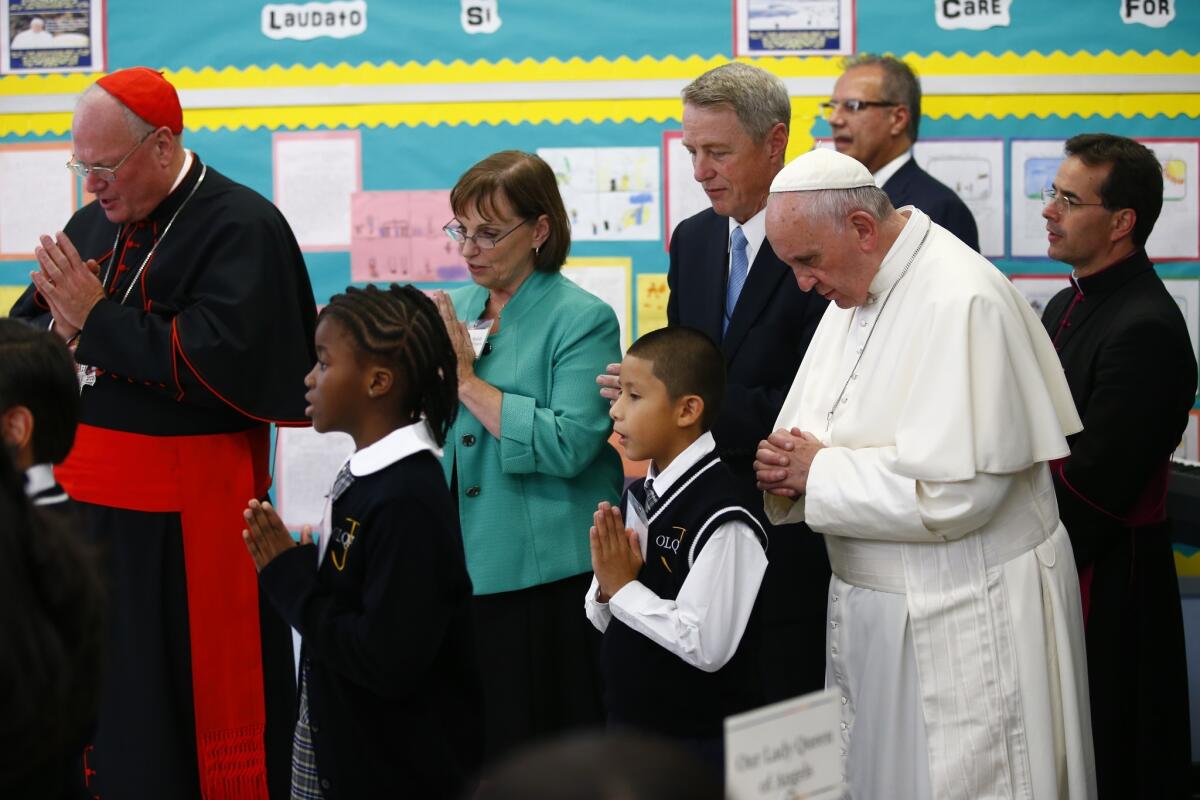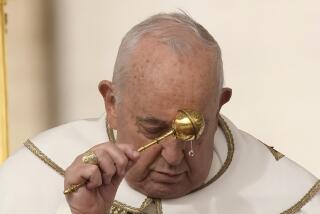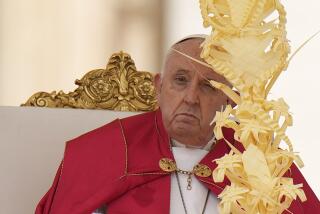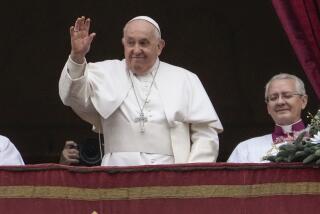Pope Francis takes his message of peace and renewal to East Harlem school

Pope Francis, accompanied by Cardinal Timothy Dolan, left, and Joanne Walsh, principal of Our Lady Queen of Angels School, prays as he visits the school in East Harlem on Friday.
Reporting from New York — After a morning of somber policy and memorials, Pope Francis took a break Friday afternoon to meet with children and bring a papal blessing to a Catholic school in East Harlem, a largely Latino and African American neighborhood where poverty and immigration are key issues.
The children sang “When the Saints Go Marching In” as Francis walked along rows of eager students who snapped selfies. The lyrics changed to “When the Pope Comes Marching In” as the pontiff entered Our Lady Queen of Angels School, where he thanked the teachers and staff members and viewed students’ projects.
Later, Francis will greet as many as 80,000 onlookers during a drive through Central Park en route to a Mass for thousands at Madison Square Garden. A concert featuring Jennifer Hudson, Gloria Estefan and Harry Connick Jr. has begun to welcome the pope, scheduled to arrive in the early evening.
Protecting immigrants has been a major theme during the pontiff’s trip to the United States, which included Washington, New York and the next leg in Philadelphia on Saturday and Sunday.
The crowd that jammed Central Park to see Francis on Friday was as diverse as the city hosting him, with people from Haiti, Puerto Rico, Greece and Brooklyn. They waved flags and Pope Francis dolls, or they just waved their arms wildly.
What united the groups was a desire to lay eyes on a man whom Mayor Bill de Blasio has called the world’s voice of conscience and moral compass.
For once, this city, famous for being jaded and for ignoring (or pretending to ignore) the stars who live among its residents seemed star-struck.
Josette Brandow leaned on a metal barrier, her perch since about 11 a.m. for Francis’ arrival several hours later. Her hands were full, with a papal flag, a large framed photograph of her husband, James, and smaller picture of her children, Jimmy, 22, and Michelle, 24.
None could be with her at the park, but Brandow’s sister-in-law, Teresa Zwosta, and Zwosta’s son, Michael, 21, were there.
As they waited patiently in the warm afternoon sun, the family spoke of the importance of their Roman Catholic faith and the pope’s visit to this city.
“I think people have been so beaten down over the years after 9/11 and Hurricane Sandy, everyone is looking for a little peace, a little understanding,” Brandow said.
The family lives in the Brooklyn enclave of Gerritsen Beach, which was hit hard by Sandy when it came ashore in 2012. Her home was flooded, as were many in the close-knit community.
Gerritsen Beach also suffered from 9/11. Several residents were firefighters killed responding to the attacks.
Sandy did more than just flood the family’s neighborhood. It added to the struggles the Catholic Church is having in New York, where dozens of Catholic schools and parishes have closed in recent years.
“Old-timers leave after something like Sandy, and they don’t return,” Brandow said. The parish school in Gerritsen Beach has closed, and while the parish has about 750 families, she said many members don’t attend church regularly.
“Our parish is in dire need. Fundraising is nearly impossible. But how do you get people back?” Brandow said, echoing the question the church is dealing with.
Francis has cut a wide swath through the city, condemning greed and calling for efforts to save the planet at a stop in the morning at the United Nations. He then ministered to the personal grief that has reshaped New York since the terrorist attack of Sept. 11, 2001, on the World Trade Center.
“This place of death became a place of life too,” said Francis during a tour of the National September 11 Memorial and Museum. The site became “a place of saved lives, a hymn to the triumph of life over the prophets of destruction and death, to goodness over evil, to reconciliation and unity over hatred and division,” he said.
Francis spoke near the underground flood wall that separates Lower Manhattan from the Hudson River. The wall, which held fast during the terror attacks, is next to what is known as the “Last Column,” the final steel beam removed from the debris. He addressed an audience of more than 400 people and religious leaders representing Jews, Muslims, Hindus and others.
Before entering the memorial Friday morning, Francis was greeted by dignitaries and spoke with 18 relatives of people who died in the attacks. Francis prayed silently and laid a white rose at the edge of one of the two pools built in the footprint of the center’s Twin Towers, surrounded by panels inscribed with the names of the nearly 3,000 people killed in the attacks in New York, at the Pentagon and in a Pennsylvania field, as well as the World Trade Center bombing in 1993.
“The flowing water is also a symbol of our tears,” the pontiff said inside the memorial, according to the Vatican’s official text of his remarks. “Tears at so much devastation and ruin, past and present. This is a place where we shed tears, we weep out of a sense of powerlessness in the face of injustice, murder, and the failure to settle conflicts through dialogue. Here we mourn the wrongful and senseless loss of innocent lives because of the inability to find solutions which respect the common good.
“This flowing water reminds us of yesterday’s tears, but also of all the tears still being shed today,” he said.
The pope brought the United Nations his message of political inclusion, concern for those in flight from poverty and oppression and the need to protect Earth’s environment.
Francis emphasized such traditional Catholic concerns as the sanctity of life, a reference to church opposition to abortion and contraception. He praised efforts to curb nuclear weapons including the recent agreement that would limit Iran’s development of such capability.
But the comments that drew the most applause from the 100 world leaders and dignitaries who packed the U.N. General Assembly on Friday morning involved the themes that have marked his papacy: concern for the poor and those fleeing political or economic oppression, coupled with the need to protect the environment and to improve and broaden the political system.
He insisted that there was a “right of the environment” and that mankind has no authority to abuse it. “Any harm done to the environment, therefore, is harm done to humanity,” he said.
The world’s most powerful countries were engaging in a “selfish and boundless thirst” for money by stripping away the world’s resources while exploiting the weak, the excluded and disadvantaged. Those outside the bounty of the world have an inherent right to education and what he has termed the “three L’s” — lodging, labor and land.
Throughout his visit, Francis has tried to bridge the divide between the powerful and the weak, the rich and the poor. He has traveled among the homeless and needy while tweaking the politically powerful for failing to do more to solve the planet’s ills.
U.N. Secretary-General Ban Ki-moon in introducing the pontiff noted Francis’ role and his moral stands.
“You are at home not in palaces, but among the poor; not with the famous, but with the forgotten; not in official portraits, but in ‘selfies’ with young people,” Ban said.
Fresh from a visit to Washington, D.C., and a well-received address to a joint meeting of Congress on Wednesday, the pope arrived at the United Nations where the flag of the Vatican flew outside for the first time. He praised the U.N. for its work in helping to fight for peace, but warned the world’s elite that there was much more to be done.
“All these achievements,” the pope said of the U.N.’s peacekeeping efforts, “are lights which help to dispel the darkness of the disorder caused by unrestrained ambitions and collective forms of selfishness. Certainly, many grave problems remain to be resolved, yet it is clear that, without all those interventions on the international level, mankind would not have been able to survive the unchecked use of its own possibilities.”
He also emphasized that there was a “true ‘right of the environment.’”
“The misuse and destruction of the environment are also accompanied by a relentless process of exclusion,” the pope said. “In effect, a selfish and boundless thirst for power and material prosperity leads both to the misuse of available natural resources and to the exclusion of the weak and disadvantaged .... Economic and social exclusion is a complete denial of human fraternity and a grave offense against human rights and the environment.
“The poorest are those who suffer most from such offenses, for three serious reasons: they are cast off by society, forced to live off what is discarded and suffer unjustly from the consequences of the abuse of the environment. They are part of today’s widespread and quietly growing ‘culture of waste.’”
The Vatican flag, with its yellow-and-white bands and triple crown topped by a cross, was raised without ceremony Friday by U.N. security officers. It stood slightly apart from the flags of the international organization’s 193 members.
On Sept. 10, the General Assembly approved a Palestinian-sponsored resolution to allow the flags of U.N. observer states to fly alongside those of member states. The Holy See and Palestine are the only two U.N. observer states.
MORE ON POPE’S VISIT:
Pope Francis blesses crowd along New York’s Fifth Avenue
Pope Francis’ teachings help inspire ‘renaissance’ among young clergy
Pope Francis tells Congress it should use its power for ‘restoring hope, righting wrongs’
More to Read
Sign up for Essential California
The most important California stories and recommendations in your inbox every morning.
You may occasionally receive promotional content from the Los Angeles Times.











